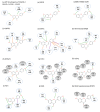Perspectives on the Role of Isoliquiritigenin in Cancer
- PMID: 33401375
- PMCID: PMC7795842
- DOI: 10.3390/cancers13010115
Perspectives on the Role of Isoliquiritigenin in Cancer
Abstract
Isoliquiritigenin (2',4',4-trihydroxychalcone, ISL), one of the most important bioactive compounds with a chalcone structure, is derived from licorice root. Licorice is commonly known as Glycyrrhiza, including Glycyrrhiza uralensis, Glycyrrhiza radix, and Glycyrrhiza glabra, which are generally available in common foods and Chinese herbal medicines based on a wide variety of biological functions and pharmacological effects, and its derivative (ISL) is utilized as a food additive and adjunct disease treatment. In this review, we summarized the progress over the last 10 years in the targeted pathways and molecular mechanisms of ISL that are involved in the regulation of the onset and progression of different types of cancers.
Keywords: apoptosis; cancer; cell signaling; isoliquiritigenin.
Conflict of interest statement
The authors declare no conflict of interest. The funders had no role in the design of the study; in the collection, analyses, or interpretation of data; in the writing of the manuscript, or in the decision to publish the results.
Figures






Similar articles
-
A Review: The Pharmacology of Isoliquiritigenin.Phytother Res. 2015 Jul;29(7):969-77. doi: 10.1002/ptr.5348. Epub 2015 Apr 24. Phytother Res. 2015. PMID: 25907962 Review.
-
The licorice flavonoid isoliquiritigenin attenuates Mycobacterium tuberculosis-induced inflammation through Notch1/NF-κB and MAPK signaling pathways.J Ethnopharmacol. 2022 Aug 10;294:115368. doi: 10.1016/j.jep.2022.115368. Epub 2022 May 16. J Ethnopharmacol. 2022. PMID: 35589023
-
[Review of pharmacological effects of Glycyrrhiza radix and its bioactive compounds].Zhongguo Zhong Yao Za Zhi. 2009 Nov;34(21):2695-700. Zhongguo Zhong Yao Za Zhi. 2009. PMID: 20209894 Review. Chinese.
-
A protective mechanism of licorice (Glycyrrhiza uralensis): isoliquiritigenin stimulates detoxification system via Nrf2 activation.J Ethnopharmacol. 2015 Mar 13;162:134-9. doi: 10.1016/j.jep.2014.12.043. Epub 2014 Dec 31. J Ethnopharmacol. 2015. PMID: 25557030
-
Isoliquiritigenin isolated from licorice Glycyrrhiza uralensis prevents 6-hydroxydopamine-induced apoptosis in dopaminergic neurons.Biosci Biotechnol Biochem. 2012;76(3):536-43. doi: 10.1271/bbb.110842. Biosci Biotechnol Biochem. 2012. PMID: 22451397
Cited by
-
Natural Chalcones and Derivatives in Colon Cancer: Pre-Clinical Challenges and the Promise of Chalcone-Based Nanoparticles.Pharmaceutics. 2023 Dec 1;15(12):2718. doi: 10.3390/pharmaceutics15122718. Pharmaceutics. 2023. PMID: 38140059 Free PMC article. Review.
-
Recent Advances in Glycyrrhiza glabra (Licorice)-Containing Herbs Alleviating Radiotherapy- and Chemotherapy-Induced Adverse Reactions in Cancer Treatment.Metabolites. 2022 Jun 9;12(6):535. doi: 10.3390/metabo12060535. Metabolites. 2022. PMID: 35736467 Free PMC article. Review.
-
The Involvement of Natural Polyphenols in the Chemoprevention of Cervical Cancer.Int J Mol Sci. 2021 Aug 16;22(16):8812. doi: 10.3390/ijms22168812. Int J Mol Sci. 2021. PMID: 34445518 Free PMC article. Review.
-
Role of Phytonutrients in Nutrigenetics and Nutrigenomics Perspective in Curing Breast Cancer.Biomolecules. 2021 Aug 9;11(8):1176. doi: 10.3390/biom11081176. Biomolecules. 2021. PMID: 34439842 Free PMC article. Review.
-
Phytochemicals targeting glycolysis in colorectal cancer therapy: effects and mechanisms of action.Front Pharmacol. 2023 Aug 24;14:1257450. doi: 10.3389/fphar.2023.1257450. eCollection 2023. Front Pharmacol. 2023. PMID: 37693915 Free PMC article. Review.
References
Publication types
LinkOut - more resources
Full Text Sources
Other Literature Sources

